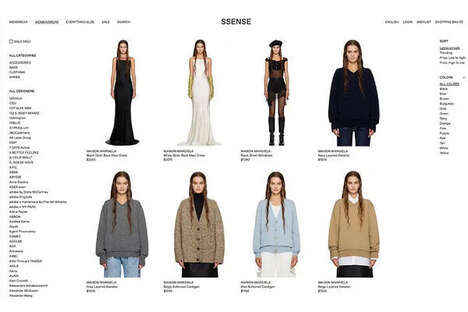Innovating Through Dupe Culture
An Interview with Vidyuth Srinivasan, CEO & Co-Founder of Entrupy
 In today's ever-evolving luxury market, the rise of dupes and counterfeit products has sparked significant debate, particularly among Gen Z consumers who often flaunt their finds. Recent reports, such as The Guardian’s article and Entrupy’s 2023 State of the Fake Report, highlight a growing trend: over 50% of Gen Z respondents show little concern for the implications of counterfeit goods. Vidyuth Srinivasan, CEO and co-founder of Entrupy, an AI-powered authentication technology for luxury handbags and sneakers, sheds light on this pressing issue. Join us as we delve into the complexities of counterfeiting, its hidden impacts on workers and the environment, and Entrupy’s mission to combat this global challenge.
In today's ever-evolving luxury market, the rise of dupes and counterfeit products has sparked significant debate, particularly among Gen Z consumers who often flaunt their finds. Recent reports, such as The Guardian’s article and Entrupy’s 2023 State of the Fake Report, highlight a growing trend: over 50% of Gen Z respondents show little concern for the implications of counterfeit goods. Vidyuth Srinivasan, CEO and co-founder of Entrupy, an AI-powered authentication technology for luxury handbags and sneakers, sheds light on this pressing issue. Join us as we delve into the complexities of counterfeiting, its hidden impacts on workers and the environment, and Entrupy’s mission to combat this global challenge.1. Vidyuth Srinivasan, can you tell me a little bit about yourself and your company Entrupy?
My name is Vidyuth Srinivasan and I am the CEO & co-founder of Entrupy, an AI-powered authenticator for luxury handbags and sneakers. The need for something like Entrupy is something I personally experienced earlier in my life. When I was in my teens and owned a motorcycle, I was sold counterfeit motorcycle batteries by an authorized dealership.
That's why, in 2016, we launched Entrupy Luxury Authentication, so that people don’t ever find themselves in a situation like mine where they’ve been scammed out of money for something that could put them in danger. Entrupy’s AI-powered technology is able to recognize the subtle differences in counterfeit products that are imperceptible to the untrained eye. Seeing a high demand in the handbag and sneaker markets, Entrupy launched its technology for use by luxury marketplaces, retailers, consignment shop owners, pawn shop proprietors, social resellers, and more. These types of businesses typically source stock from individual consigners rather than verified sellers, placing them at higher risk of counterfeit scams. To ensure the authenticity of an item, those businesses would normally have to employ the help of a verification expert, which can be expensive and time-consuming. Through Entrupy, they can verify an item within minutes, thus providing a high level of trust with their customers.
Today, Entrupy changes the way customers shop for pre-loved luxury items. By providing a certificate of authenticity for every verified bag or sneaker on the device, customers are not only able to feel confident in what they are purchasing, but they are also able to put their trust in the seller they are buying from. Entrupy works with thousands of businesses including major platforms like TikTok Shop and retailers including The Purse Ladies, Wasteland, Fiesta Texas Pawn, Treasures of NY, Santa Monica Jewelry & Loan, and Wyld Blue to name a few, to authenticate luxury handbags and sneakers from brands including Louis Vuitton, Prada, Dior, Balenciaga, Gucci, YSL, Burberry, and so many more. By doing so, the technology ensures, with a 99.1% accuracy rate, that its partners are guaranteeing the authenticity of their products backed by AI.
2. What does innovation mean to you, both personally and professionally, especially in the context of combating counterfeit goods?
Counterfeiting is not a victimless crime and most businesses will not want to discuss this problem. We sit somewhere in the middle between businesses and consumers and feel a responsibility to educate the market on this problem. But first and foremost, working on this problem is a bit of a spy vs. spy game. We build tech, counterfeiters try to beat it, then we improve very quickly, constantly looking for new ways to sniff them out. It is an every day challenge that involves sourcing new fakes, new authentic products, gathering data and improving the algorithms. Personally, this is a very gratifying responsibility because I am deeply convinced that the existence of technologies like us are a net positive for society.
3. What are your thoughts on the recent trend of embracing dupes and counterfeit products in the fashion industry?
As this recent trend of embracing “dupes” and knock-off items continues to grow, it becomes clearer that not many people know about the negative effects that these copycat items have on the fashion industry. In fact, Entrupy’s most recent State of the Fake report revealed that over 50% of Gen Z respondents were not concerned with the issues behind fakes.
While people often feel that it’s not worth buying expensive luxury bags because there are such high quality fakes out there, what many people don’t know is that counterfeiting actually has a direct and devastating impact on both workers and the environment. For example, the lost revenue due to counterfeiting led to over 260,000 lost jobs.
Given this, it is very concerning to hear more and more about recent trends of shoppers, heavily influenced by Gen Z consumers, who are embracing dupes and counterfeit products. However, by providing technology that calls out these counterfeit goods and delivering educational tools such as our annual State of the Fake Reports, Entrupy aims to solve the challenges luxury brands face when it comes to counterfeiters.
4. How do you think brands should respond to the increasing acceptance of counterfeit culture among Gen Z?
With the recent news around social media experts encouraging high end luxury brands to embrace the recent rise in popularity of dupes and counterfeit products, given Gen Z’s shopping behaviors, brands find themselves in an interesting position.
On the flipside, in general, brands do not want to talk about this issue as it doesn't gel well with their aspirational marketing. I think this is a great opportunity for them to educate consumers on the issues behind counterfeit products and shed light on solutions, like Entrupy, and resellers, whose mission is to protect consumers and businesses from purchasing counterfeit items rather than listen to those who are telling them to encourage such shopping behavior. Entrupy’s authentication system is a valuable tool for brands, sellers and resellers to protect themselves and their customers.
5. How does your team generate new ideas and maintain a pipeline of fresh concepts to stay ahead of counterfeiters?
-Research - Sourcing new fakes, understanding manufacturing trends and specifics for every brand we support.
-Better training - Our algorithms are a sponge for data and new signals that can sniff out fakes, so feeding them right and training them is equally important.
6. How does Entrupy’s technology work to combat the rise of counterfeit goods?
AI is able to look at details as well as the holistic picture of the item that the human eye will never be able to. Traditional authentication methods tend to rely on the human eye, which has proven to be faulty over the years as it has become harder and harder to determine what’s real and what’s not. Not to mention, it has also become harder to find, train and scale the knowledge across human authenticators.
That’s why Entrupy uses artificial intelligence technology and machine learning to authenticate items. When an item is scanned using our proprietary device and app, a set of microscopic images are collected, then our machine learning algorithms that have been trained with a growing database of millions of similar images, including pieces that date back to the 1920s, is making a judgment on its authenticity, assisted by a human when needed. Over the years, we have collected data from both real and fake items, and trained our AI systems to be able to understand the minute differences between them.
As our inventory grows, our technology advances. To date, Entrupy has amassed over 20 million unique images of both authentic and counterfeit items. Based on the results of the initial comparison, the AI will either verify the item’s authenticity or return an “unverified” result. Each scan from an Entrupy device becomes part of the database, further refining the algorithms and making our solution smarter and more accurate.
7. Looking to the future, how do you see the battle against counterfeit goods evolving, and what role will Entrupy play in it?
Looking to the future, we hope to go beyond the retail world. When we first launched, we looked at a bunch of different markets such as art, food, pharmaceuticals, etc. and found that handbags were in high demand and sneakers were seemingly next. When we learned that almost anything you can think of can be faked, we realized that we wanted to build a solution that is scalable. As we look at the next few years, we will continue to grow our database of images to continue ensuring authenticity of luxury items and set out to become the standard for authentication technologies across various markets.
All that being said, Entrupy is not only on a mission to just combat the spread of counterfeit goods through its technology, but we are on a mission to spread awareness of the issues that surround counterfeit products and the act of counterfeiting in general. As it stands, there are a handful of technologies and solutions in place to protect businesses and consumers from transacting in counterfeit products. We hope to be at the forefront of the fight against counterfeiting, a crime that often goes unnoticed and has evolved into a trillion dollar industry (bigger than both drug and human trafficking).
References: entrupy


